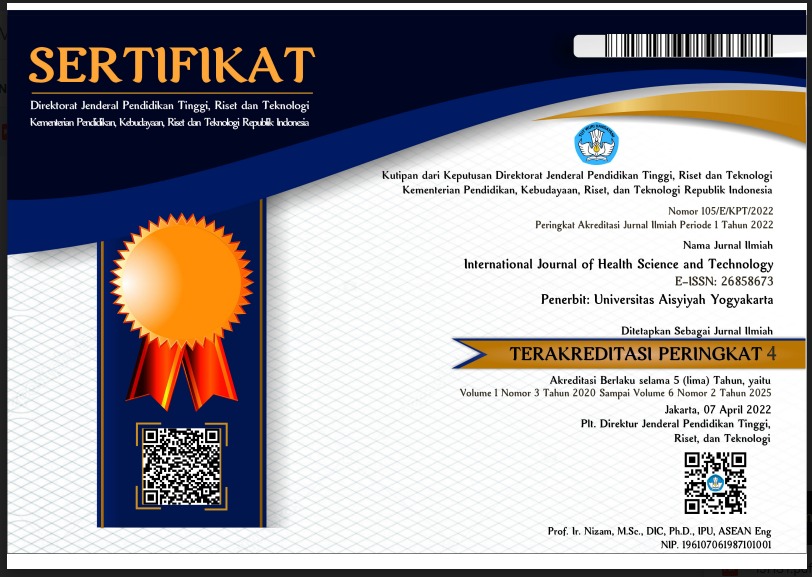Soy milk and avocado juice: what is the best to reduce cholesterol among obesity children?
DOI:
https://doi.org/10.31101/ijhst.v1i2.1098Keywords:
Cholesterol, besity, soy milk, avocado juiceAbstract
References
American Academy of Pediatrics. (2011). Physicians Recommend all Children, Ages 9-11, Be Screened for Cholesterol. Available from https://www.aap.org/en-us/about-the-aap/aap-press-room/Pages/Physicians-Recommend-all-Children,-Ages-9-11,-Be-Screened-for-Cholesterol.aspx.
Anies.(2015). Kolesterol & Penyakit Jantung Koroner. Yogyakarta: Ar-Ruz Media.
California Avocado Comission.(2015). Nutriens in Avocado dalam http://www.avocadocentral.com, diakses pada 10 Desember 2015.
Commission on Ending Childhood Obesity. (2016).Report of the Commission on Ending Childhood Obesity; World Health Organization: Geneva, Switzerland
Gracia, M. (2014). Hypolipidemic potential of plants used in Cuba. Pharmacologyonline Volume 1, 2014, Pages 73-80. ISSN: 1827-8620.
Helen.(2014). Ketahui Aneka Manfaat Buah Alpukat dalam http://www.gizi.depkes.go.id.
Higgins et al. (2018). Pediatric reference intervals for calculated LDL cholesterol, non-HDL cholesterol, and remnant cholesterol in the healthy CALIPER cohort. Clinica Chimica Acta 486 (2018) 129–134. DOI: 10.1016/j.cca.2018.07.028.
Holmes, L. et al. (2016). Racial and Ethnic Heterogeneity in the Association Between Total Cholesterol and Pediatric Obesity. International Journal of Environmental Research and Public Health; Basel Vol. 13, Iss. 1. DOI: 10.3390/ijerph13010019.
Kanetro, B. dan Hastuti, S. (2006). Ragram Produk Olahan Kacang-Kacangan. Yogyakarta: Unwama Press.
Kouda, K. et al. (2011). Effect of Recovery From Obesity on Cardiovascular Risk Factors Among Japanese Schoolchildren: The Iwata Population-Based Follow-Up Study. Journal Epidemiologi 2011;21(5):370-375. DOI: 10.2188/jea.JE20100140.
Laker, M. (2006). Memahami Kolesterol. Jakarta: PT Grafika Multi Warna.
Lembaga Ilmu Pengetahuan Indonesia (LIPI). (2009). Kolesterol. Jakarta: Balai Informasi & Teknologi LIPI Pangan & Kesehatan.
Lieskayanti, D. T.(2011). Pengaruh Pemberian Susu Kedelai Terhadap Kadar Kolesterol pada Penderita Diabetes Mellitus Tipe II di Puskesmas Piyungan Bantul Yogyakarta. Skripsi tidak dipublikasikan: Program Studi Ilmu Keperawatan STIKES ‘Aisyiyah Yogyakarta.
Maharani, D.(2016). Alpukat Terbukti Bisa Turunkan Kolesterol dalam http://health.kompas.com, diakses pada 8 Oktober 2015.
Melania.(2012). Mewaspadai Kolesterol Tinggi! dalam https://plus.google.com, diakses pada 12 Mei 2016.
Ministry of Health of Indonesia. (2013). National Baseline Health Research (RISKESDAS). Jakarta: Badan Litbang Kesehatan.
Muchtadi, D. (2010). Kedelai Komponen Utama untuk Kesehatan. Bandung: AlfaBeta.
Mumpuni, Y. dan Wulandari, A. (2011). Cara Jitu Mengatasi Kolesterol. Yogyakarta: Penerbit ANDI.
Ogden, C. L. et al. (2010). Prevalence of high body mass index in US children and adolescents. The Journal of the American Medical Association, 303(3), 242e249. DOI: 10.1001/jama.2009.2012.
Septianggi, F. N., Mulyati, T. dan Sulistya, H. (2013). Hubungan Asupan lemak dan Asupan Kolesterol dengan Kadar Kolesterol Total pada Penderita Jantung Koroner Rawat Jalan di RSUD Tugurejo Semarang. Jurnal Gizi Universitas Muhammadiyah Semarang, Volume 2, No. 2, November 2013.
Syahrul et al. (2016). Prevalence of underweight and overweight among school-aged children and it's association with children's sociodemographic and lifestyle in Indonesia. International Journal of Nursing Sciences. Volume 3, Issue 2, June 2016, Pages 169-177. DOI: 10.1016/j.ijnss.2016.04.004.
Usman, M. (2014). Pengaruh Konsumsi Buah Alpukat (Persea americana Mill) Terhadap Kadar Kolesterol Total Pada Pasien Hiperkolesterol di Puskesmas Padang Pasir Kota Padang. Skripsi dipublikasikan: Fakultas Kedokteran & Ilmu Keperawatan Universitas Andalas.
Wijnhoven, T. et al. (2014). WHO european childhood obesity surveillance Initiative: School nutrition environment and body mass index in primary schools. International Journal of Environmental Research and Public Health, 11(11), 11261e11285. DOI: 10.3390/ijerph111111261.
Downloads
Published
How to Cite
Issue
Section
Citation Check
License
International Journal of Health Science and Technology allows readers to read, download, copy, distribute, print, search, or link to its articles' full texts and allows readers to use them for any other lawful purpose. The journal allows the author(s) to hold the copyright without restrictions. Finally, the journal allows the author(s) to retain publishing rights without restrictions
- Authors are allowed to archive their submitted article in an open access repository
- Authors are allowed to archive the final published article in an open access repository with an acknowledgment of its initial publication in this journal

This work is licensed under a Creative Commons Attribution-ShareAlike 4.0 Generic License.










